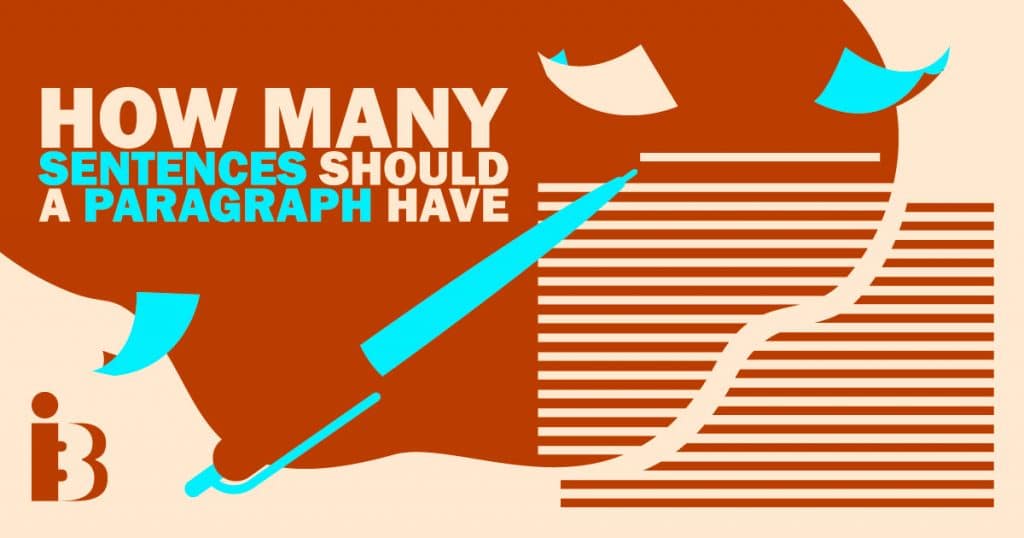How many sentences are there in a paragraph?
It’s a common question if you’re new to the world of content creation.
On one hand, you want to ensure your paragraphs are all carefully constructed to deliver value. A paragraph should outline key information in a simple, straightforward structure. On the other hand, if you’re not vigilant, paragraphs can easily become too long, particularly when you have a lot of information to share on a specific idea or topic.
The longer the paragraph, the more daunting it can appear to your reader.
The length of a paragraph can vary depending on the type of writing you’re producing. In the online world, it’s typical to see paragraphs separated into smaller sections for blogs and articles. Shorter paragraphs can help to make content more legible, and easier to consume.
In the offline landscape and academic world, paragraphs are usually longer, anywhere up to about 8 sentences.
Today, we’re going to look at how many sentences you should include in each paragraph for your content.
The Key Components of a Paragraph
Paragraphs are a core component of the writing world. They’re essentially bundles of sentences, connected by a core idea or theme. Each sentence in a paragraph should be connected, allowing the reader to flow from one section to the next as easily as possible.
As mentioned above, the structure of a paragraph can vary depending on what you’re writing. The answer to “how many sentences are in a conclusion paragraph” can differ greatly from the answer to “how many sentences are in a body paragraph”. Conclusions typically summarise a number of key topics, while body paragraphs provide a deep-dive into a certain idea.
Regardless of the size of your paragraph, it should always include the following key elements:
- Unity: Your paragraph should revolve around a key thought or concept. Each sentence should reflect components of the same underlying idea.
- Order: Paragraphs should be structured in an easy-to-follow format. For instance, most paragraphs start with an introduction, followed by a body, then a conclusion sentence.
- Coherence: A good paragraph should always be easy to understand. Sentences need to be connected by a follow-on word, and everything should work together as a whole.
- Relevance: Each paragraph should be connected to the core focus of the “segment” of your piece. For example, a paragraph in a section of an article about content writing strategies might cover all of the components of a specific writing methodology.
How many sentences should a paragraph have?

At school, we’re taught certain rules for writing. We learn sentences shouldn’t be too long or complex, and that every essay or piece should follow a specific structure. Most teachers will tell you the average paragraph should be no longer than 3-5 sentences. However, paragraphs can extend all the way up to 8 sentences in length, depending on the style of writing.
The type of content you produce will determine not only the length of the piece, but the length of each complementary sentence and paragraph. Academic papers usually have longer paragraphs, because the topics covered in each section of the piece are more complex. Blog posts often have shorter paragraphs to make the content easier to digest.
Ultimately, a paragraph should have as many or as few sentences as it needs to convey the right information. Each paragraph should feel complete, informative and cohesive, regardless of size.
How many words in a sentence?
The length of your paragraphs will usually be determined in part, by the length of your sentences. The average sentence has anywhere between 10-20 words. However, in some styles of writing, creators prefer to stick to shorter sentences, as they’re easier to consume. Sentences longer than around 20 words often need to be broken up to ensure they don’t become “run-on sentences”.
How many words in a paragraph?
If we follow the idea that the average paragraph should have between 3-5 sentences, then the average number of words in a paragraph will usually range from around 50-150 words. However, once again, the exact length of your paragraph in words and characters will depend on your style of writing.
Tips for Writing Strong Paragraphs
Although it can be helpful to have a clear idea in mind of how many sentences each paragraph should include, it’s important to remember that length isn’t the only factor determining whether a paragraph is good or bad. Both long and short paragraphs can miss the mark if they’re not properly constructed. To write more effective paragraphs:
- Choose your sentences carefully: When writing a paragraph, the aim of the first sentence should always be to encourage your reader to continue to the next. Start by introducing your idea in a concise way, then build on your concept with your following sentences.
- Maintain a consistent idea: Remember, your paragraphs should stick to a single point or concept from beginning to end. Make sure you don’t jump between different thoughts, as this could make your writing look like a stream of consciousness.
- Start new paragraphs carefully: Many writers aren’t sure when they should start a new paragraph. In general, every time you begin exploring a new idea or point, it should begin with a new paragraph. Just ensure the paragraphs are connected by an underlying theme if they appear in the same segment of your content.
- End paragraphs correctly: Good paragraphs end with a closing sentence which summarises the concepts you’ve already covered. The conclusion should emphasise the overall point of the paragraph.
- Use transition words: Transition words help to create flow between sentences. Words like “therefore”, “so” and “consequently” help to connect your sentences together. These terms are very useful to make your writing feel more natural and cohesive.
Make the Most of Your Paragraphs
Answering the question, “How many sentences are there in a paragraph” can be quite complex, as there’s no one-size-fits-all approach. Some people believe paragraphs should be between 3-5 sentences in length, while others feel paragraphs can easily range up to 8 sentences without being problematic.
It all depends on the content you’re creating, your audience and your style of writing.



